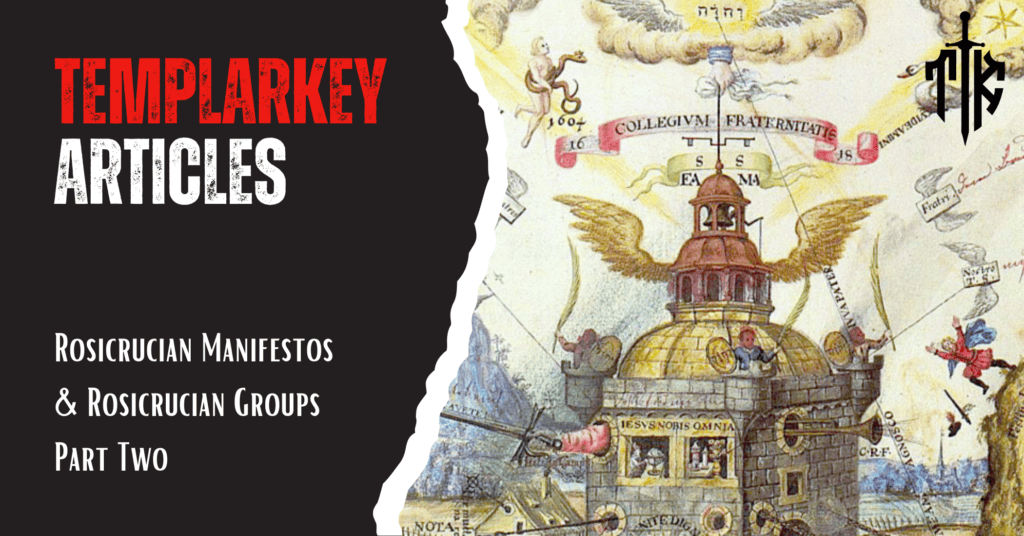Rosicrucian Manifestos and Rosicrucian Groups
This is part of a series of articles on the historical Rose+Croix and the later various neo-Rosicrucian organisations. Other articles will deal with various subjects related to the historical Rose+Croix, including key historical and mythological figures, books, and various later neo-Rosicrucian organisations. For the origin of the meaning and practises of the Rose+Croix before and during Johann Valentin Andreae, see our Rose+Croix Special Edition magazine Issue 12 [March 2025]. It explores the Secret of the Rose+Croix Templarkey offers to modern Rosicrucians.
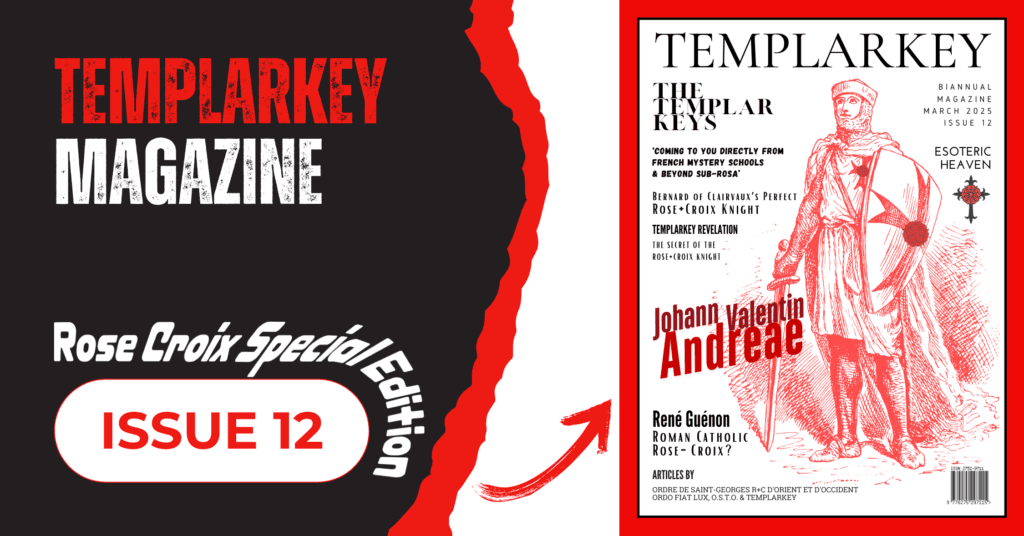
Three Rosicrucian manifestos, published in the early 17th century, are foundational texts of the Rosicrucian movement. They are:
- Fama Fraternitatis (1614) – The Fame of the Fraternity of the Rosy Cross
- Confessio Fraternitatis (1615) – The Confession of the Fraternity of the Rosy Cross
- Chymical Wedding of Christian Rosenkreuz (1616) – An Alchemical Allegory of Spiritual Initiation
These texts inspired centuries of esoteric thought, influencing Freemasonry, Theosophy, and neo-Rosicrucian movements. However, the original Rose+Croix ideals in these texts differ significantly from later Rosicrucian reinterpretations.
Additional Works by the Tübingen Circle
The manifestos were not the only Rosicrucian writings of the time. They were part of a larger intellectual movement by a group of authors known as the Tübingen Circle, associated with Johann Valentin Andreae and other Lutheran intellectuals. These thinkers produced additional works, including:
- “Turris Babel” (1619) – A utopian satire by Andreae criticising intellectual and societal flaws.
- “Christianopolis” (1619) – Andreae’s vision of a Christian utopia, influenced by Rosicrucian ideals.
- “Mythologiae Christianae” (1619) – A symbolic exploration of Christian mysticism.
Many scholars believe that the Rosicrucian manifestos were meant as allegorical or satirical works rather than descriptions of an actual secret society. Later, esoteric groups reinterpreted the manifestos, leading to neo-Rosicrucian movements that departed from their original meaning.
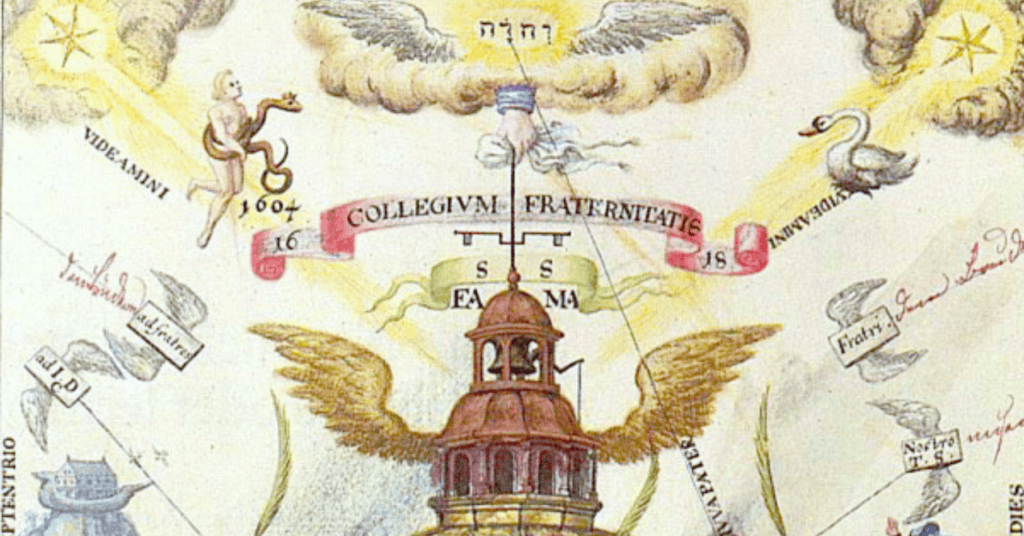
Summary of Key Themes from Fama Fraternitatis
The Fama Fraternitatis, the first manifesto, introduces the legend of Christian Rosenkreuz (CRC) and the mystical Fraternity of the Rosy Cross. It describes:
- The Life of Christian Rosenkreuz – A German noble who, after travelling through the Middle East and North Africa, returns to Europe with hidden wisdom.
- The Foundation of the Rosicrucian Fraternity – CRC gathers a small group of enlightened individuals to preserve and spread this esoteric knowledge.
- The Hidden Tomb of CRC – A mysterious underground vault, rediscovered after 120 years, filled with mystical symbols, alchemical texts, and a perfectly preserved body of CRC.
- A Call for Spiritual Renewal – The text invites scholars and seekers to embrace the esoteric wisdom of the Fraternity and help reform European thought.
Core Messages of Fama Fraternitatis
✅ Hidden knowledge exists but is only for the worthy.
✅ A secret Fraternity works for humanity’s spiritual enlightenment.
✅ Science, religion, and philosophy should be united.
✅ Materialism and ignorance must be abandoned for true wisdom.
The Fama presents a utopian vision of transformation—but it is unclear if the Fraternity was ever meant to be a real organisation or an allegory for intellectual enlightenment.
Comparing Confessio Fraternitatis vs. Fama Fraternitatis
| Aspect | Fama Fraternitatis (1614) | Confessio Fraternitatis (1615) |
|---|---|---|
| Tone | Mythological & narrative | Philosophical & doctrinal |
| Purpose | Introduces Christian Rosenkreuz & the Brotherhood | Explains the mission & philosophy of the Brotherhood |
| View on Society | Critiques corruption in religious & political institutions | More explicitly calls for reform |
| Attitude Toward Secrecy | Suggests the Brotherhood exists in hiding | Reinforces that the Brotherhood is invisible to the public |
| Scientific & Mystical Themes | Alchemy, hidden wisdom, sacred knowledge | Cosmic harmony, divine will, universal enlightenment |
This comparison highlights how Confessio expands upon the ideas in Fama, reinforcing the Brotherhood’s spiritual mission.
Core Messages of Confessio Fraternitatis
✅ The Rosicrucian Fraternity is divinely guided.
✅ Only those who are spiritually prepared can understand the mysteries.
✅ The Fraternity seeks to harmonise religion, science, and mysticism.
✅ Their wisdom will only be revealed to those who are worthy.
While Fama Fraternitatis is more narrative and symbolic, the Confessio Fraternitatis expands on its philosophical ideas, emphasising that the Fraternity’s mission is spiritual, not political.
Neo-Rosicrucianism vs. the Original Rosicrucian Fraternity
Many modern Rosicrucian groups claim descent from the original Rosicrucian ideals. However, their teachings often diverge significantly from the early manifestos.
Neo-Rosicrucianism vs. the Original Rosicrucian Fraternity
| Aspect | Original Rosicrucianism (1614-1616) | Neo-Rosicrucian Movements (18th-20th Century) |
|---|---|---|
| Historical Origin | Based on the Rosicrucian Manifestos (Fama, Confessio, Chymical Wedding) | Emerging in the 18th century through Masonic and occult movements |
| Core Teachings | Christian mysticism, Hermeticism, spiritual enlightenment | Blend of Eastern mysticism, ceremonial magic, and Theosophy |
| Structure | No formal hierarchy or initiation system | Developed complex initiatory structures (e.g., SRIA, Golden Dawn, AMORC) |
| Symbolism | The Rose and the Cross as symbols of spiritual transformation | Incorporated additional Masonic and alchemical symbols |
| Membership | Conceptual brotherhood, not a physical organization | Organized societies with membership requirements |
| Philosophy | Spiritual enlightenment through self-study and divine wisdom | Often blended with magical practices, occult rituals, and esoteric teachings |
| Legacy | Inspired later esoteric movements and philosophical thought | Transformed into structured initiatory systems influencing Freemasonry and New Age movements |
This comparison highlights the evolution from the original Rosicrucian philosophy to modern initiatory systems.
Chymical Wedding of Christian Rosenkreuz: Allegory of Initiation
Unlike the first two manifestos, the Chymical Wedding of Christian Rosenkreuz (1616) is a highly symbolic, allegorical tale rather than a philosophical treatise.
The Story in Brief:
Christian Rosenkreuz receives a mystical invitation to attend a royal wedding. He undergoes seven days of trials and initiations, encountering strange alchemical symbols and moral dilemmas. At the end, he witnesses the alchemical transformation of the King and Queen, symbolising spiritual rebirth. Templarkey has more in-depth knowledge included within the magazines of this and other Johann Valentin Andreae Rose+Croix mysteries.
The Alchemical & Initiatory Meaning
✅ Spiritual purification – CRC’s journey represents the soul’s refinement.
✅ Alchemy as transformation – The wedding represents the union of opposites (Sun & Moon, Male & Female, Spirit & Matter).
✅ A coded initiation story – The trials correspond to stages of spiritual awakening.
✅ Divine guidance & hidden wisdom – CRC is being prepared for higher knowledge, just as initiates in esoteric traditions undergo symbolic deaths and rebirths.
Final Thoughts: Are the Rosicrucian Manifestos Literal or Allegorical?
There is no historical evidence of a real Rosicrucian Order in 1614—only the ideas published in the manifestos. Many scholars believe these texts were:
- Philosophical allegories promoting esoteric Christianity and intellectual renewal.
- A call for Hermetic & alchemical study disguised in mystical language.
- A satirical work by Johann Valentin Andreae, mocking secret societies.
Later groups transformed Rosicrucianism into a structured initiatory system, diverging from its original intellectual and spiritual ideals.
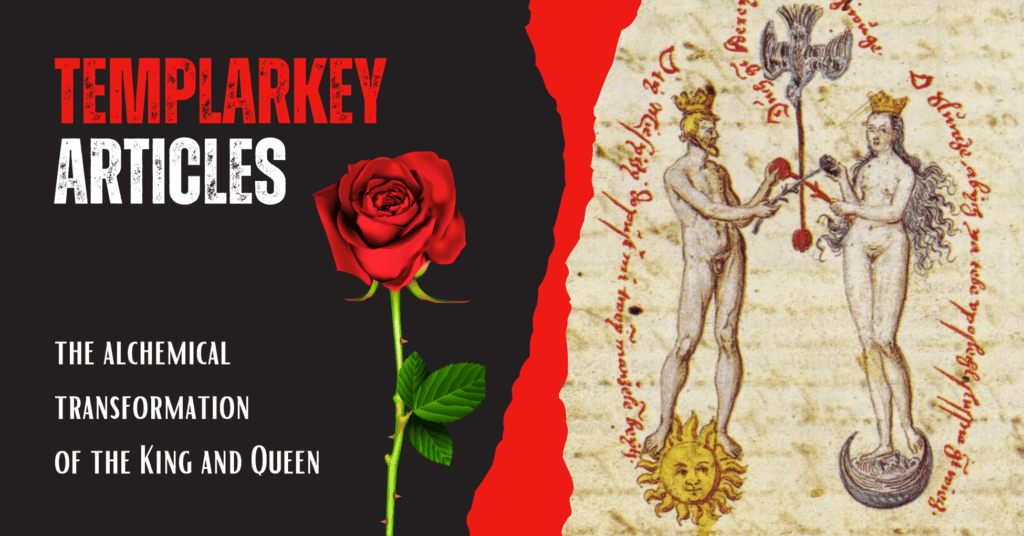
The Emergence of Various Rosicrucian Groups & Their Initiatory Systems
The original Rosicrucian Manifestos (1614-1616) described a secretive, enlightened Fraternity devoted to spiritual wisdom, alchemy, and esoteric Christianity. However, there is no historical evidence that such a fraternity ever physically existed in the 17th century. Instead, later groups reinterpreted Rosicrucian ideals and transformed them into structured initiatory systems, blending them with Freemasonry, Hermeticism, Theosophy, and ceremonial magic.
Below is a list of various Rosicrucian groups that emerged over the centuries, each shaping Rosicrucianism into a ritualistic order with structured degrees, initiations, and mystical teachings.
1. The Gold- und Rosenkreuz (Golden and Rosy Cross) (1750s–1780s, Germany)
Overview & History
- One of the earliest attempts to turn Rosicrucianism into an actual order was the Gold- und Rosenkreuz (Golden and Rosy Cross), which emerged in Germany in the mid-18th century.
- It was deeply connected with Freemasonry and sought to blend alchemy, Christian mysticism, and esoteric science into an initiatory system.
Initiatory Structure & Practices
✅ Strict hierarchical structure – Members advanced through nine degrees of initiation.
✅ Alchemy as the primary spiritual practice – Members studied practical alchemy, the transmutation of metals, and spiritual purification.
✅ Strong Christian influences – Teachings emphasised the perfection of the soul through Christ and Hermetic transformation.
Key Figures
- Hermann Fictuld – One of the main authors of the Golden and Rosy Cross texts.
- Johann Christoph von Wöllner – A high-ranking member who later influenced Prussian Freemasonry.
Influence on Later Movements
The Golden and Rosy Cross directly influenced 19th-century occultism and was one of the first groups to turn Rosicrucianism into a structured initiation-based order.
2. Societas Rosicruciana in Anglia (SRIA) (1865, England)
Overview & History
- Founded in 1865 in England by Robert Wentworth Little, SRIA was an attempt to revive Rosicrucianism as an initiatory system within Freemasonry.
- Only Master Masons were allowed to join, making it a Masonic esoteric order rather than an independent Rosicrucian society.
Initiatory Structure & Practices
✅ Nine-degree system – Mirrored the Gold- und Rosenkreuz structure, with a focus on esoteric Christian mysticism, Hermeticism, and Kabbalah.
✅ Alchemy, astrology, and Hermetic philosophy – Members studied symbolism, initiation rites, and spiritual enlightenment.
✅ Masonic exclusivity – Unlike earlier Rosicrucian traditions, SRIA required Masonic initiation as a prerequisite.
Key Figures
- Robert Wentworth Little – Founder, connected with British Freemasonry.
- Dr. William Wynn Westcott – Later became head of SRIA and co-founded the Hermetic Order of the Golden Dawn.
Influence on Later Movements
SRIA directly influenced the Golden Dawn, Theosophy, and modern Masonic Rosicrucian groups.
3. The Hermetic Order of the Golden Dawn (1888, England)
Overview & History
- The Golden Dawn was founded in 1888 by William Wynn Westcott, Samuel Liddell MacGregor Mathers, and Dr William Robert Woodman.
- While not purely Rosicrucian, its teachings were heavily influenced by SRIA, Hermetic Kabbalah, and ceremonial magic.
- The Second Order (R.R. et A.C.) was explicitly Rosicrucian, focusing on alchemical and theurgical practices.
Initiatory Structure & Practices
✅ Three Orders of Initiation:
1. Outer Order – Focused on Western mysticism, Kabbalah, and divination (Tarot, Astrology, Alchemy).
2. Second Order (R.R. et A.C.) – Focused on Rosicrucian teachings, inner alchemy, and magical rituals.
3. Third Order (The Secret Chiefs) – A mystical concept of hidden masters guiding the Order.
✅ Complex initiation rites – Based on ritual magic, visualisation, and Hermeticism.
✅ Practical magic and spiritual development – Members engaged in theurgical operations, pathworking, and ritual invocation.
Key Figures
- William Wynn Westcott – Co-founder, linked to SRIA.
- S.L. MacGregor Mathers – Main ritualist and architect of Golden Dawn’s Rosicrucian structure.
- Aleister Crowley – Later expanded on Golden Dawn teachings in his Thelemic system.
Influence on Later Movements
The Golden Dawn’s Rosicrucian teachings influenced modern ceremonial magic, Wicca, and Thelema.
4. Ancient Mystical Order Rosae Crucis (AMORC) (1915, USA)
Overview & History
- Founded by Harvey Spencer Lewis in 1915 in the United States.
- Unlike previous Masonic-based Rosicrucian orders, AMORC was designed as a self-initiatory, non-Masonic system open to all seekers.
Initiatory Structure & Practices
✅ Structured self-initiation system – Based on lesson books (monographs) mailed to members.
✅ Teachings include – Spiritual alchemy, reincarnation, healing techniques, and cosmic consciousness.
✅ Non-Masonic & open to all – Unlike SRIA and Golden Dawn, AMORC does not require Freemasonry.
Key Figures
- Harvey Spencer Lewis – Founder, claimed to have received Rosicrucian initiation in France.
- Ralph M. Lewis – Expanded AMORC globally in the mid-20th century.
Influence on Later Movements
AMORC is one of the largest modern Rosicrucian organisations, influencing New Age and mystical movements.
How Rosicrucianism Became a Structured Initiatory System
- The original Rosicrucian Manifestos were likely philosophical allegories, not blueprints for an actual society.
- 18th-century groups (Gold- und Rosenkreuz) turned Rosicrucianism into a hierarchical system with secret teachings and degrees.
Masonic Rosicrucian Orders (SRIA, Golden Dawn) merged Rosicrucianism with Freemasonry and ritual magic. - Modern groups (AMORC, The Rosicrucian Fellowship) made Rosicrucianism accessible to the general public through self-study initiations.
Comparison of Rosicrucian Groups & Their Initiatory Systems
| Rosicrucian Group | Founded | Key Founders | Initiatory System | Core Teachings |
|---|---|---|---|---|
| Gold- und Rosenkreuz | 1750s (Germany) | Hermann Fictuld, Johann Christoph von Wöllner | Nine-degree system, Masonic influence | – Alchemy, Christian mysticism, inner purification – Spiritual transformation through secret knowledge |
| SRIA (Societas Rosicruciana in Anglia) | 1865 (England) | Robert Wentworth Little, William Wynn Westcott | Nine-degree Masonic system | – Hermeticism, Christian Kabbalah, esoteric studies – Requires Masonic initiation for membership |
| Hermetic Order of the Golden Dawn | 1888 (England) | William Wynn Westcott, MacGregor Mathers | Three-tier initiation system | – Ritual magic, Hermetic Kabbalah, Tarot, Theurgy – Inner Order (R.R. et A.C.) explicitly Rosicrucian |
| AMORC (Ancient Mystical Order Rosae Crucis) | 1915 (USA) | Harvey Spencer Lewis | Self-initiation, monograph system | – Cosmic consciousness, spiritual alchemy, healing – Open to all seekers, no Masonic requirement |
Each of these Rosicrucian groups structured their initiatory systems differently, blending mystical, Hermetic, and Masonic elements.
The Transition from the Gold- und Rosenkreuz to the Rose Croix d’Or
The Gold- und Rosenkreuz (Golden and Rosy Cross) was one of the earliest structured Rosicrucian initiatory orders, emerging in Germany in the mid-18th century. However, by the late 18th and early 19th centuries, the order declined due to internal conflicts, political repression, and the changing landscape of esoteric traditions.
Some former members and successors of the Gold- und Rosenkreuz played a role in the creation of the Rose Croix d’Or (Golden Rose Cross), an esoteric group that emerged in France and later in Germany. This transition marked a shift toward a more mystical, universalist interpretation of Rosicrucianism, distinct from the Christian and Masonic structures of earlier Rosicrucian groups.
The Gold- und Rosenkreuz (Golden and Rosy Cross) – The Foundation
Structure & Teachings of the Gold- und Rosenkreuz (1750s–1780s). The Gold- und Rosenkreuz was a highly structured order deeply influenced by alchemy, Christian mysticism, and Freemasonry. It had:
✅ A Nine-Degree Initiatory System – Progressing from Apprentice to Magus, each level involved spiritual purification, Hermetic knowledge, and alchemical symbolism.
✅ Christian Esotericism – It emphasised the perfection of the soul through Christ and Hermetic transformation.
✅ Alchemical Practices – Members studied practical and spiritual alchemy, seeing physical transmutation as a metaphor for inner enlightenment.
✅ Secrecy & Elitism – Membership was exclusive, requiring Masonic affiliation and Christian faith.
However, by the end of the 18th century, the Gold- und Rosenkreuz declined due to several factors:
❌ Freemasonry’s influence weakened in Germany due to political repression.
❌ The Enlightenment era led many intellectuals to question esoteric traditions.
❌ Internal power struggles caused division among members.
How Some Gold- und Rosenkreuz Members Formed the Rose Croix d’Or
After the decline of the Gold- und Rosenkreuz, some members sought to revive Rosicrucian teachings in a more mystical and universalist way. This led to the formation of La Rose Croix d’Or (The Golden Rose Cross) in the early 19th century.
Unlike the Gold- und Rosenkreuz, which was highly Masonic and alchemical, the Rose Croix d’Or:
- Shifted focus from external alchemy to inner transformation.
- Embraced a more mystical and spiritual approach, rather than rigid Freemasonic structures.
- Became open to non-Masonic seekers, making it accessible to a broader audience of spiritual aspirants.
This marked the evolution of Rosicrucianism from a secretive elite group into a more accessible spiritual tradition.
The Rose Croix d’Or & Its Evolution into Modern Rosicrucianism
The Rose Croix d’Or was not a single organisation but a name used by various Rosicrucian movements in the 19th and 20th centuries. Some key groups that were inspired by it include:
- The Rose-Croix of Toulouse (19th century, France) – A mystical order that sought to revive Rosicrucian ideals.
- L’Ordre Kabbalistique de la Rose-Croix (1888, France) – Founded by Stanislas de Guaita, it mixed Kabbalah, Hermeticism, and Rosicrucianism.
- The Golden Dawn’s Second Order (R.R. et A.C.) (1892, England) – The “Inner Order” of the Golden Dawn was explicitly Rosicrucian in name and teachings.
- Max Heindel’s Rosicrucian Fellowship (1909, USA) – Combined Rosicrucian philosophy with Christian mysticism and astrology.
- AMORC (Ancient Mystical Order Rosae Crucis) (1915, USA) – A modern Rosicrucian organisation that follows a self-initiation system based on mystical enlightenment.
Final Thoughts on Rosicrucian Manifestos and Rosicrucian Groups: From Elitist Order to Universal Mysticism
The shift from the Gold- und Rosenkreuz to the Rose Croix d’Or reflects a broader trend in Western esotericism:
✅ Moving away from strict Masonic secrecy toward spiritual universalism.
✅ Transforming alchemy from a material practice into a metaphor for inner enlightenment.
✅ Expanding from a small elite circle to a worldwide spiritual tradition.
The legacy of these transformations continues in modern Rosicrucian groups, many of which trace their origins back to these early movements.
The Transition from the Gold- und Rosenkreuz to the Rose Croix d’Or & Rose Croix d’Orient
The Gold- und Rosenkreuz (Golden and Rosy Cross), a structured alchemical-mystical society, began to decline in the late 18th century, leading some of its members to establish new Rosicrucian movements. Among these, the Rose Croix d’Or (Golden Rose Cross) and the Rose Croix d’Orient (Oriental Rose Cross) were significant in shaping the esoteric Rosicrucian revival of the 19th century. These new groups moved away from strict Masonic secrecy and emphasised spiritual enlightenment, alchemical transformation, and universalist mysticism. See the end of this article for the Rose Croix d’Orient.
The name “Rose Croix d’Or” (in French, literally “Golden Rose Cross”) is most commonly used as the French designation of the Lectorium Rosicrucianum, also known in English as the “International School of the Golden Rosycross.” In its modern form, this movement was established in the Netherlands in the early 20th century by three principal figures:
- Johannes Jacobus (“Jan”) Leene, who later took the name Jan van Rijckenborgh (1896–1968)
- Zwier Willem (“Wim”) Leene (1892–1938), Jan’s brother
- Henriette Stok-Huizer, who adopted the spiritual name Catharose de Petri (1902–1990)
Although one sometimes sees references to historical “Golden and Rosy Cross” groups dating back to 18th-century Germany (often called Gold- und Rosenkreuz), the modern organization using the name Rose Croix d’Or in French traces its direct lineage to the founders above and the Lectorium Rosicrucianum school they established.

Quick Summary
Name: Lectorium Rosicrucianum (International School of the Golden Rosycross)
French designation: Rose Croix d’Or
Founders: Jan van Rijckenborgh (Johannes Jacobus Leene) Wim Leene (Zwier Willem Leene) Catharose de Petri (Henriette Stok-Huizer)
Founded: Began in the Netherlands in the mid-1920s to 1930s
These three worked to continue and reinterpret the Rosicrucian spiritual tradition for modern seekers, emphasizing inner transformation, Christian Hermeticism, and the universal wisdom tradition. While many Western esoteric groups do employ an explicit ladder of degrees, the Rose Croix d’Or (Lectorium Rosicrucianum) does not operate in that manner. It offers a single, evolving path for the seeker—centred around interior transformation—rather than a series of ritualized, numbered initiations. Consequently, anyone inquiring about “how many degrees” in the Lectorium Rosicrucianum will not find a formal structure akin to other Rosicrucian or Masonic organizations.
Key Differences Between Rosicrucian Orders
| Aspect | Gold- und Rosenkreuz (1750s) | Rose Croix d’Or (19th Century) | Rose Croix d’Orient (19th Century) |
|---|---|---|---|
| Structure | Highly hierarchical, nine-degree system | Less rigid, focused on mystical development | More fluid, blending Western and Eastern teachings |
| Core Focus | Alchemy, Christian esotericism, Masonic secrecy | Inner transformation, Hermetic Christianity | Mystical fusion of East and West, spiritual politics (Synarchy) |
| Membership | Exclusive to Masons and Christians | Open to all spiritual seekers | Diverse membership, including those interested in Eastern wisdom |
| Initiation System | Strictly regimented nine-degree progression | Three-degree system focused on inner enlightenment | No rigid degree structure, initiations based on mystical understanding |
| Symbolism | Christian cross, alchemical symbols | Rose and Cross, Kabbalistic influences | Egyptian, Persian, and Kabbalistic symbols |
| Philosophy | Moral perfection through alchemy and Christian mysticism | Personal spiritual enlightenment through Hermeticism | Spiritual awakening through a synthesis of mystical traditions |
| Influence | Later Freemasonic Rosicrucian groups | Martinism, the Kabbalistic Order of the Rose-Cross | Theosophy, modern esoteric Christianity, and Synarchy movements |
Each of these Rosicrucian orders shaped the evolution of Western esotericism, from structured initiatory paths to mystical universalism.
References & Suggested Reading
Heindel, Max. The Rosicrucian Cosmo-Conception. Rosicrucian Fellowship, 1909. A foundational text for the Fellowship that first introduced the Leene brothers to Rosicrucian Christianity.
Van Rijckenborgh, Jan. Gnosis in the Present Time. Rozekruis Pers. Outlines the Lectorium Rosicrucianum’s approach to Christian Gnosis and the path of transfiguration.
Faivre, Antoine. Access to Western Esotericism. State University of New York Press, 1994. Provides a scholarly framework for identifying key motifs within Rosicrucian and esoteric Christian traditions.
Strube, Julian. Socialist Religion and the Emergence of Occultism: A Genealogical Approach to Socialism and Secularization in 19th-Century France. Religion, 2017. While not addressing the Lectorium specifically, gives essential context on how esoteric and universalist ideas merged in modern Europe.
Churton, Tobias. The Invisible History of the Rosicrucians. Weiser, 2009. Covers multiple strands of the modern Rosicrucian revival, including references to lesser-known groups influenced by the original 17th-century texts.
FARC: Who or What Are the “Frères Aînés de la Rose-Croix”?
Esoteric Concept, Not a Conventional Order
Unlike many Rosicrucian bodies that can be traced to specific individuals and founding dates, the “Elder Brothers of the Rose Cross” are described as advanced adepts or initiates—a small group of spiritually elevated beings guiding humanity’s evolution behind the scenes.
Max Heindel’s Role
In his seminal work, The Rosicrucian Cosmo-Conception (1909), Max Heindel claimed that these Elder Brothers instructed him in esoteric Christianity and cosmology. He presented them as guardians of the true Rosicrucian wisdom, operating from a secret spiritual centre sometimes called the Temple of the Rose Cross.
Connection to The Rosicrucian Fellowship
Heindel founded The Rosicrucian Fellowship (TRF) in 1909 in Oceanside, California. TRF’s teachings revolve around Christian mysticism, astrology, and esoteric principles said to originate with the Elder Brothers of the Rose Cross.
No Single ‘Founder’
Because “Frères Aînés de la Rose-Croix” refers to a hidden hierarchy of advanced souls (rather than a regular organisation), there is no single historical founder in the way we can point to a founder for a physical Rosicrucian group (like Jan van Rijckenborgh for the Lectorium Rosicrucianum).
Historical/Legendary Roots
Rosicrucian lore dating back to the early 17th century (Fama Fraternitatis, Confessio Fraternitatis, and the Chymical Wedding) speaks of a secret Fraternity guiding spiritual seekers. Heindel framed the Elder Brothers as the continuation of this hidden fraternity in the modern era.
Quick Summary
- Name (French): Frères Aînés de la Rose-Croix (Elder Brothers of the Rose Cross)
- Nature: A spiritual or esoteric hierarchy, not an ordinary association
- Modern Popularisation: Through Max Heindel and his 1909 work, The Rosicrucian Cosmo-Conception
- Key Organisation Linked to Them: The Rosicrucian Fellowship (founded 1909)
- Core Idea: They are enlightened beings or initiates overseeing the Rosicrucian current and aiding humanity’s evolution
In essence, the “Frères Aînés de la Rose-Croix” were never “founded” by one person as a normal association. Instead, they are portrayed as timeless inner guardians of the Rosicrucian tradition, accessible—according to Heindel—only through advanced spiritual discipline and initiation.
Rose Croix d’Orient: Origins, Key Figures, and Legacy
The term Rose Croix d’Orient (sometimes rendered “Rose+Croix d’Orient” in esoteric literature) refers to a little-known, often elusive current within modern Western esotericism. Unlike other Rosicrucian or Martinist orders with public statutes and documented membership lists, the Rose Croix d’Orient appears primarily in connection with Max Théon (1848–1927) and later, in mid-twentieth-century France, with Robert Ambelain (1907–1997). This article brings together the known historical context, principal figures, and alleged lineage that collectively form the story of the Rose Croix d’Orient.
Historical and Occult Context
The early 20th century “Occult Revival” began between the late 19th and early 20th centuries. Western Europe witnessed a resurgence of interest in Hermeticism, Kabbalah, Christian mysticism, and Rosicrucian traditions. Various secret or semi-secret orders emerged or were revived during this period—ranging from the French Ordre Kabbalistique de la Rose-Croix (founded by Stanislas de Guaita and Joséphin Péladan) to the Martinist orders of Gérard Encausse (Papus), and to splinter Masonic rites like Memphis-Misraïm. Within this milieu, esotericists often wove together strands of Gnosticism, Templar lore, Theosophy, and Rosicrucianism into complex initiatic frameworks.
Max Théon and the “Oriental Rosicrucian” Lineage
Born in Poland under the name Louis (sometimes “Louis-Maximilian”) Bimstein, Théon later adopted the pseudonym Max Théon. By the turn of the 20th century, he had relocated to Tlemcen, in Algeria, with his wife Mary Chrystine Woodroffe Ware—referred to as Alma Théon or Madame Théon. Together, they established what they called the Cosmic Movement around 1900.
The Cosmic Movement
While the Cosmic Movement was an esoteric circle focused on spiritual evolution, cosmology, and “cosmic traditions,” it was never structured as a public, membership-based order in the manner of many Rosicrucian or Masonic organisations. Instead, Théon taught a syncretic system of mysticism and Hermetic principles, with an emphasis on a purportedly ancient “Eastern” or “Oriental” current of Rosicrucianism.
Rose Croix d’Orient
Théon claimed or implied that he represented a secret “Oriental Rosicrucian lineage”, sometimes referred to as the Rose+Croix d’Orient. Unlike the famous 17th-century Rosicrucian manifestos (e.g., Fama Fraternitatis, Confessio Fraternitatis), there are no widely circulated texts or initiatic charters associated with “Rose Croix d’Orient.” Most references to it surface in anecdotes or statements by Théon, Alma Théon, and later commentators who allude to an esoteric tradition entrusted to Théon by unidentified Eastern adepts.
Mirra Alfassa (The Mother)
Notably, Mirra Alfassa—the future “Mother” of the Sri Aurobindo Ashram in India—studied with Alma and Max Théon in Tlemcen between 1906 and 1908. In her early diaries and later recollections, she acknowledged the formative influence of the Théons’ teachings. However, neither Mirra Alfassa nor her subsequent circle in Pondicherry formally promulgated the “Rose Croix d’Orient” as an external order.
Robert Ambelain and the Mid-20th Century French Esoteric Revival
Who Was Robert Ambelain? Robert Ambelain (1907–1997) was a central figure in 20th-century French occultism. He:
- Claimed high degrees or direct successions in a variety of esoteric orders, including Martinist groups, Gnostic churches, and Egypt-influenced Masonic rites (Memphis-Misraïm).
- Authored many books on ceremonial magic, Kabbalah, astrology, and the hidden dimensions of Freemasonry.
- Often strove to revive or “revalidate” lineages that he believed had fallen dormant, fusing them into a unified initiatic system.
Ambelain’s Connection with the Rose Croix d’Orient
At some point, Ambelain referenced or claimed aspects of the so-called “Oriental Rosicrucian” lineage linked to Max Théon. By mid-century, he had become known for blending multiple currents—Rosicrucian, Martinist, Egyptian Rite, and Gnostic—into an overarching French esoteric synthesis. Within certain private correspondences and smaller circles, “Rose Croix d’Orient” surfaced as part of Ambelain’s recognised lineages, though rarely as a stand-alone public order.
In other words, under Ambelain:
- The Rose Croix d’Orient functioned more as an inner mystical current than a fully fleshed-out organisation with regular publications or lodges.
- It mirrored many esoteric revivals of the period, where lines of alleged apostolic or initiatic succession were declared valid by a key person and propagated in small, discreet groups.
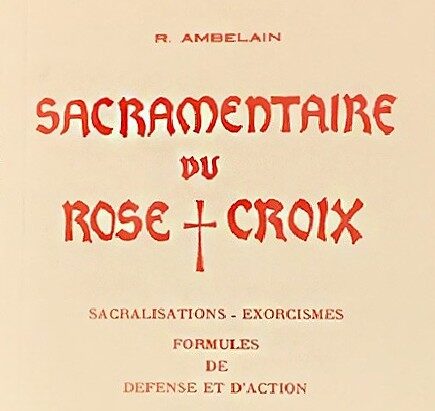
Assessment of the Rose Croix d’Orient
Because the Rose Croix d’Orient never operated as an open, structured society, documentation remains scarce. Unlike other Rosicrucian traditions—such as AMORC (Ancient & Mystical Order Rosae Crucis), the Lectorium Rosicrucianum, or historical French branches (e.g., Ordre Kabbalistique de la Rose-Croix)—there are no extensive archives, membership logs, or official statements. Instead, the Rose Croix d’Orient persists as:
- A thematic or initiatic concept introduced by Max Théon, purporting to continue a hidden “Eastern” Rosicrucian tradition.
- A subsequent esoteric lineage recognised or revived by Robert Ambelain among the many lines he synthesised.
In this sense, the Rose Croix d’Orient stands at the crossroads of mythic lineage and esoteric claim. Its ambiguous historical record is reflective of a broader tendency in occult circles to posit secret, ancient, or oriental sources for Western mysticisms. The “Orient” often served as a symbol of hidden wisdom for European occultists, reinforcing both exoticism and perceived authenticity.
Rose-Croix d’Orient and Spiritual Alchemy
According to the initiation into the Esoteric and Astral Rose-Cross of Egypt, conferred in Cairo within a Rosicrucian circle in 1912 upon George Boge de Lagrèze, transmitted (around 1946) by him to Robert Ambelain.
“… no writing, no trace on the physical plane, but a power of radiance and a genuine transmission. The Society of Unknown Philosophers was one of its mystical realizations; the Élus Coëns, an operative manifestation. In return, nothing will be asked of you but… silence.”
(Excerpt from a letter by George Bogé de Lagrèze to Robert Ambelain.)
Transmission of the Oriental R+C
An altar furnished with: a wax candle, a Bible, and a censer (with R+C incense).
While lighting the candle:
“Let the invisible presence of E:. A:., the ‘Founder of GOD,’ guide and protector of the Rose+Cross, be summoned among us.”
While lighting the censer:
“Let us recollect ourselves, my brother, so that our spirits and hearts may be in union, beyond death, with those of the past Masters, with whom we are bound by the Spirit and the Truth in our head, the Light of the World; the Anointed of Light, the unique Mediator of the Human Species, the Way, the Truth, the Life, the Primal Light, Wisdom, the sole Medium by which humans can return to God: the CHRIST.”
Initiation formula:
“Receive, my brother, by this sign (X) the initiation into the Esoteric Astral Rose+Cross of Egypt as it was secretly conferred upon me by my consecrator, according to the rule with no writing and no trace on the physical plane.”
While extinguishing the candle:
“Invisible yet present Master E:. A:., guide of the R+C, Angels and Spirits who have assisted us, we give you thanks; may the Peace of God always remain between you and us. Amen.”
Claimed Lineage and Secret Transmission
The text describes a “Rose-Croix d’Orient and Spiritual Alchemy” tradition, said to be rooted in teachings once transmitted by Louis-Claude de Saint-Martin (an influential 18th-century mystic). It then references an “Esoteric and Astral Rose-Cross of Egypt,” reportedly conferred in Cairo in 1912 upon George Bogé de Lagrèze and passed on around 1946 to the French occultist Robert Ambelain. According to the account, the speaker received this same transmission secretly in 1958.
Emphasis on Oral/Invisible Initiation
The excerpt insists there is “no writing, no trace on the physical plane”—suggesting a tradition reliant on a purely oral or “radiant” (spiritual) mode of initiation. The letter connects this type of transmission with the Society of Unknown Philosophers (a mystical realization) and the Élus Coëns (a more operative, ritual-oriented branch of Martinism).
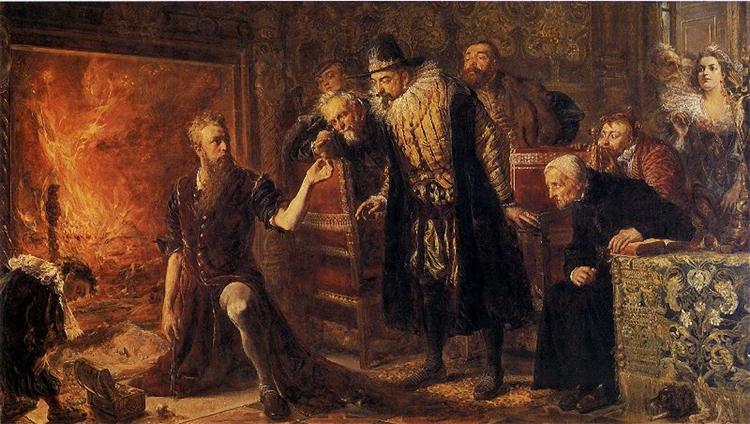
Ritual Outline
The text presents a brief ritual setup: An altar with a candle, a Bible, and a censer. Invocations calling upon E:. A:., (depicted as a protective figure of the Rose-Cross) and culminating in a reference to Christ as the ultimate spiritual Mediator. A formal initiation formula, conferring the “Esoteric Astral Rose+Cross of Egypt” in a silent and secret manner. A closing gesture of gratitude to invisible guides and spirits.
Connection to the Rose Croix d’Orient
This text underscores how Robert Ambelain and his circle perceived (or inherited) a lineage termed “Rose-Croix d’Orient.” They linked it to older Martinist–Rosicrucian influences (Saint-Martin, Élus Coëns) while asserting continuity with an alleged Egyptian and esoteric Rosicrucian current from early 20th-century Cairo.
Significance for the Rose Croix d’Orient
It provides ritual evidence of a strand of Rosicrucian spirituality integrating Christian, Martinist, and ‘Egyptian’ elements. It highlights the secret, oral nature of this transmission, aimed at preserving “power of radiance” rather than leaving extensive written records. The text reveals the Christocentric orientation characteristic of many French occult and Martinist traditions, even when combined with Hermetic or Egyptian symbolic frameworks.
By including this translation and summary in our discussion of the Rose Croix d’Orient, we illustrate how certain 20th-century French occult circles—particularly those tied to Robert Ambelain—understood and practised an inner, Christ-oriented Rosicrucianism believed to stem from both Saint-Martin and purported “Egyptian” initiations.
Conclusion
The story of the Rose Croix d’Orient is inseparable from the lives and teachings of Max Théon and later Robert Ambelain. Both men operated within overlapping streams of Western esotericism—Hermetic, Rosicrucian, and Martinist—during eras of heightened occult experimentation. While the Rose Croix d’Orient never attained the organisational prominence of other Rosicrucian or Masonic bodies, its legacy endures in scattered references and in the writings of those who claim to perpetuate Théon’s “Oriental Rosicrucian” current.
Ultimately, the Rose Croix d’Orient remains a fascinating footnote in the tapestry of modern Rosicrucian history: a reminder that esoteric lineages often blend historical fact with mystic romance, leaving researchers with much to untangle—and no small amount of mystery.
Key Teachings & Practices
✅ Mystical blend of East and West – Combined Hermetic Kabbalah, Christian mysticism, and Eastern esotericism.
✅ Focus on spiritual enlightenment – Sought inner transformation over ritual-based initiation.
✅ Symbolism drawn from Egyptian and Persian sources – Used Oriental iconography and sacred geometry.
✅ Belief in Synarchy – A spiritual-political system where enlightened initiates guide humanity toward harmony.
Legacy & Influence
- Inspired Theosophy, modern Rosicrucian groups, and occult societies.
- Influenced the Gnostic Catholic Church and mystical Christianity.
- Contributed to the Western fascination with Eastern mysticism in the late 19th and early 20th centuries.
Final Thoughts on Rosicrucian Manifestos and Rosicrucian Groups
The Shift from the Gold- und Rosenkreuz to the New Rosicrucian Movements
- The Gold- und Rosenkreuz was an exclusive, Masonic-alchemical order that declined by the late 18th century.
- The Rose Croix d’Or emerged as a revivalist movement, focusing on inner alchemy and universal spiritual wisdom.
- The Rose Croix d’Orient introduced Eastern esotericism into Western Rosicrucian thought, shaping modern occult traditions.
These movements paved the way for modern Rosicrucian organisations, such as AMORC, the Rosicrucian Fellowship, and the Kabbalistic Order of the Rose-Cross.
Selected Academic and Reference Sources
Churton, Tobias. The Invisible History of the Rosicrucians: The World’s Most Mysterious Secret Society. Weiser, 2009. Provides a broad overview of Rosicrucian traditions and touches on many 19th- and 20th-century revivals, though references to Théon’s lineage are brief.
Heehs, Peter. The Lives of Sri Aurobindo. Columbia University Press, 2008. Includes background on Mirra Alfassa (The Mother) and her time in Tlemcen with Max and Alma Théon.
Van Vrekhem, Georges. The Mother: The Story of Her Life. Rupa & Co., 2000. Offers details on Mirra Alfassa’s formative esoteric influences and thus indirectly informs on Max Théon’s activities.
Ambelain, Robert. La Franc-Maçonnerie oubliée. Éditions Niclaus, 1970. Though primarily focused on Freemasonry, Ambelain’s work alludes to lesser-known rites and lineages, shedding some light on how he integrated esoteric transmissions.
Faivre, Antoine. Access to Western Esotericism. SUNY Press, 1994. Provides a scholarly framework for understanding how occult movements (including those claiming Rosicrucian pedigree) fit into the broader category of Western esotericism.
(Note: While these sources discuss various aspects of Rosicrucian history, Théon’s Cosmic Movement, and French occult revivals, none contain an extensive “official” history of the Rose Croix d’Orient. The lineage remains largely preserved through personal testimonies, scattered documentation, and the private teachings of esoteric circles).
